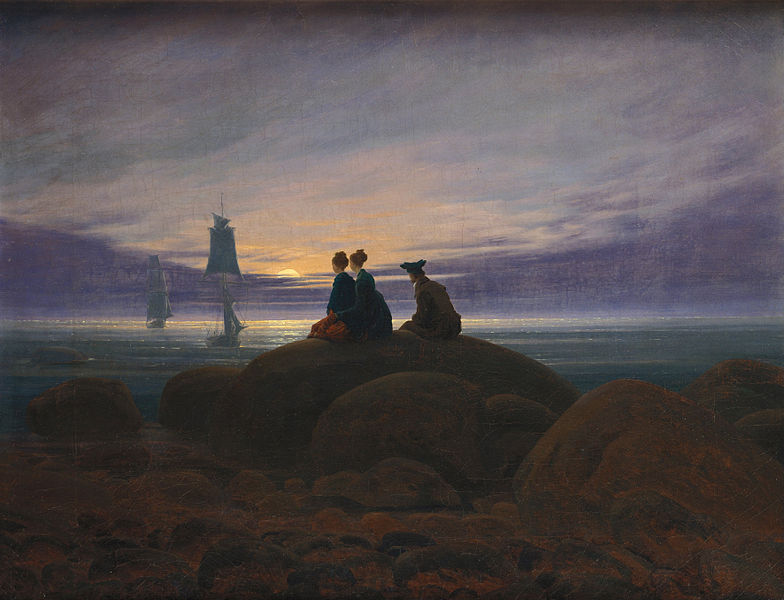Saturday, May 2, 2015
Some thoughts on Germanness, a lonely tree and Cinderella
This 1822 painting by Caspar David Friedrich, The Lonely Tree (Der einsame Baum), I saw last November at the British Museum. It was part of an exhibition devoted to the many different ways Germans view their history. You may ask why out of the blue I've decided to write about this today, and there are a couple of reasons, which I'll come to.
But first about this painting. At the centre, an ancient oak stands damaged but alive, its branches dark in silhouette, projecting into the largely overcast morning sky. A shepherd shelters under the leafy lower branches, his flock grazing in a spacious meadow. In the middle distance nestles a village, with tree-clad hills that pile up into blue-grey mountains in the background. The oak tree, according to the exhibition notes, has since the romantic period been a symbol of the German nation; and one interpretation of the painting (I don't know if it's the artist’s own) is that the tree is Germany, battered by Napoleon but unbowed, continuing to shelter the German people. A potent symbol of German nationalism, 50 years before Germany existed as a state.
German nationalism: the very words make us queasy … and yet … why should the Germans uniquely amongst European peoples of the 19th century, be denied their nationalism just because we have the advantage of knowing the history of the 20th? You could say that nationalism has been the bane of world history. It might be a foolish and unhistorical thing to say: but foolish or not, I've said it. And if the statement has any value at all (though I'm ready concede that maybe it doesn't) it applies to German nationalism no more and no less than to Irish nationalism, or any other nationalism.
Grimms Fairy Tales
Now to the two reasons I'm writing about this today. One is that for my birthday six weeks ago Albert gave me Philip Pullman’s Grimm Tales, translations from fairy tales assembled by the Grimm brothers, Jacob and Wilhelm, Kinder- und Hausmärchen (Children's and Household Tales). This work has become a pivotal component in the idea of Germanness, and featured in the same Germany exhibition where I saw the lonely tree painting. The tales were first published in 1812, which as Neil MacGregor points out in his guidebook to the exhibition, is a significant date.
By that year, Napoleon had conquered and occupied most of Germany and had annexed wide stretches of the Rhineland. Cologne was a city in France. Yet to the brothers Grimm (who were language scholars as well as folk tale collectors) Germany had something of immense value which the French could not claim: a language reaching back into the mists of pre-history. In the time of the Roman Empire, the French had abandoned their Celtic tongue and adopted Latin, the language of the conquerors. Not so the Germans, most of whom lived outside the empire’s borders, and kept their language, which along with their folktales, so the story goes, furnished them with an identity that no foreign invader could eradicate. And the tales, collected by the Grimm brothers, became part of a German political and cultural renaissance.
As to the second reason for writing about Caspar David Friedrich now: I'm just back from Vienna where with Cork Astronomy Club members I visited the Vienna university observatory and heard a fascinating impromptu talk by the senior scientist there, Dr Thomas Posch. He drew our attention to another picture by Caspar David Friedrich from the same year 1822, Moonrise over the Sea (Mondaufgang am Meer).
Why this grabs me, and what it has to do with astronomy (I doubt you'll guess) is work for another day.
Ugly sisters not ugly
Finally a few words about Grimms Fairy Tales. They include Cinderella, Snow White and Hansel and Gretel and there are about two hundred more. The Grimm versions are surprisingly, sometimes shockingly, different. Cinderella has no fairy godmother, her ugly sisters are not ugly but they do have their eyes pecked out by pigeons. I recommend an episode of BBC Radio’s In Our Time, where a few years ago Melvyn Bragg discussed the Grimm tales with three specialists. I'm not sure I prefer Philip Pullman’s translations to an 1853 version I have, but then, without knowing German, how do I know? What I do recommend the Philip Pullman book for is the note at the end of each tale commenting on the story, drawing parallels, and giving the ATU number. Not sure what an ATU number is? I dealt with this a few years ago in connection with King Midas and his asses ears.
Subscribe to:
Post Comments (Atom)


No comments:
Post a Comment